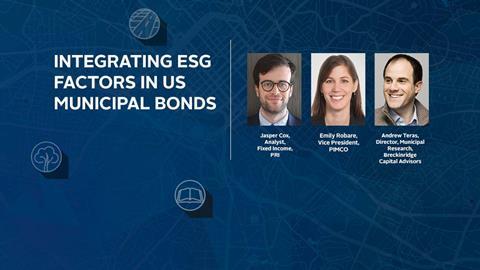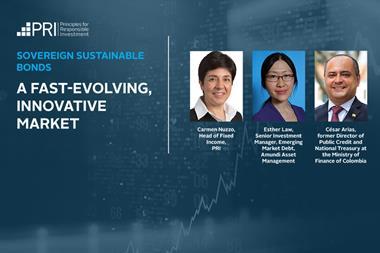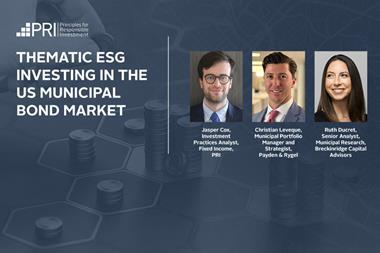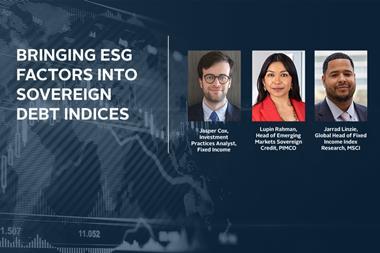Find the podcast transcript here
Integrating ESG factors in US municipal bonds
With Jasper Cox, Investment Practices Analyst, Fixed Income, Emily Robare, Vice President, Pimco, and Andrew Teras, Director, Municipal research, Breckinridge Capital Advisors
Note: The Principles for Responsible Investment podcast is designed to be heard. If you are unable to do this, this transcript offers an insight into the episode.
Transcripts are generated using a combination of speech recognition software and human transcribers, and may contain the occasional error. Please check the corresponding audio before quoting in print.
Subscribe to the channel via Apple podcasts, Spotify, or wherever you listen to your podcasts.
Jasper Cox
Hello and welcome to the PRI podcast. My name is Jasper Cox, and I’m an analyst in the fixed income team at the PRI. The question of how investors should consider environmental, social and governance risks in US municipal bonds is gaining more and more attention. In September 2020, S&P Global ratings referenced among other factors, the killing of George Floyd and the subsequent Black Lives Matter protests when changing its outlook for the city of Minneapolis is general obligation debt from stable to negative. Why would these events relevant to the entity’s credits? Well, S&P pointed to potential costs related to reform of policing, potential liabilities from lawsuits related to Floyd’s death and increased worker compensation claims related to unrest. It also said that it could revisit its view if the city’s governance, if its approach to police reform perpetuated the risk of great unrest. S&P returned the city to a stable outlook this October. This episode may be a sign of how investors in muni bonds should factor in social risks and broader ESG related questions.
Today, we are going to delve into the topic of ESG integration and muni bonds. I’m delighted to have here with me, Emily Robare, who is vice-president at PIMCO and chair of our sub-sovereign debt advisory committee and Andrew Teras, who is Director of municipal research at Breckenridge Capital Advisors and also a member of the advisory committee. Welcome both. And thank you for taking the time to join me today.
Emily Robare
Thank you.
Andrew Teras
Thank you, Jasper.
Jasper Cox
To start with Andrew, what is driving investors to think about ESG incorporation in muni bonds?
Andrew Teras
Yeah, so I think there’s a, you know, a few things going on. You know, some of which you already sort of highlighted in your intro, but, you know, I guess just to lay the groundwork. And to start out the US municipal bond market, you know, traditionally we’ve been, we’re thought of as a very safe asset class, a sleepy market, so to speak with very low default rates. And so it’s hard. You know, it’s been hard to really sort of justify or assess like how much quote unquote value add, ESG integration would bring. And the other issue, you know, their issue is that in terms of data - to assess ESG factors - it’s just very difficult to obtain versus, you know, the sovereign bond market or the corporate bond market.
And then, one thing that’s definitely, happening is that, in terms of client interest in ESG issues, environmental, social governance issues, has grown substantially in the last five years or so. Some of that, you know, may reflect a generational shift in the buyer base of municipal bonds. You know, younger folks tend to meet more engaged on these issues and those people are in a better position to be inheriting a wealth and, and looking to beyond know, potentially more thoughtful with the way they invest their money. In terms of like, you know, so I think there’s that going on. And then also, you know, what’s driving investors to think about ESG. I think the, you know, the other thing is that there’s just, there’s a few like salient or emerging issues that are going on that people are thinking about more.
In terms of - in the environmental category are specifically related to climate risk. You’re seeing the frequency and severity of extreme weather events, it’s getting greater and greater attention. You know, recent examples would be the winter storms in Texas last winter which basically knocked out the state’s power grid caused huge problems. More recently flooding in the Northeast hurricane Ida - you know, these are things that investors are observing and wondering to the extent that potentially these things may start to impact credit quality or is it the security and the safety of the bonds that they hold.
You know - in the other sort of category, I think that that’s really come to light is something that Jasper you mentioned at the beginning which you know, I think racial and social justice issues are getting more and more attention. You know, I think just recently during the pandemic, we’ve had, you mentioned the George Floyd killing which was something that got a lot of attention. There’s been other sort of police brutality type cases across the country that have also gotten a lot of attention. And then just like the pandemic itself, just as exacerbated, just structural inequalities, across race, income, gender and people are just paying more attention to those things.
Jasper Cox
Thanks, Andrew, I’d like to come back to a couple of those issues you raised, but first, just to clarify, the term ESG comes a range of approaches from both investors and issuers, and sometimes there’s confusion in the muni market. At the PRI we’ve focused on what we call the integration approach to ESG investment in muni bonds. Although we’re going to look at other approaches to Emily, do you mind explaining what we mean by this term integration?
Emily Robare
Yes, Jasper I’m happy to discuss this part because I think in any conversation on ESG, this is a really important place to start. I’ve found over the years that when you say ESG to someone, everybody has a very different idea in their mind of what you were actually talking about. So, when we’re talking about ESG integration or incorporation, which is our topic of discussion today, we’re really focused on the risk opportunity side of things. So in a lot of ways you can think of it as amplified credit risk focused, specifically on E S and G factors. So that would be some of the things, you know, Andrew discussed and that, you know, Jasper that you brought up on the climate side. Really thinking about how we’re looking at climate change with all of our investments, the social sides, thinking about things like demographic changes, the governance side, thinking about budget impasses, poorly managed liabilities, things like that would be the risk, incorporation side. The other side of ESG, what I prefer to call sustainable investing to avoid confusion is really thinking about impact in thinking about how are the bond proceeds being used, what projects are being funded.
Sometimes this is looking at the issuer as well in policies or practices of the issuer, but it’s often really focus on the use of bond proceeds and what investors may want to support either to try to align with their values, or if there’s projects they’re particularly passionate about, or that they may not want to support. So, it may also involve not supporting things like coal powered plants or prisons or jails. So that whole side of things that sustainable investing side is where we talk about green bonds, social bonds, sustainability bonds, any of those areas that everyone, you know, I think is really interested in on people’s minds lately. So we are not talking about those today - that will be a future piece so stay tuned today. We’ll be focused on the more on the ESG integration risk side of things.
And just one thing to add. I think it’s a really important distinction, not just for us to have a better conversation here today, but I’ve also seen it have real world consequences. So the Department of Labour put out a few years ago, a bulletin on ESG issues and fiduciary duty. And if you look at that, there’s a lot of conflating of these two sides of risk and impact there. So a lot of criticisms of ESG I think are often more on the impact side, but they get added to the risk side because people get confused. I’ve seen it come up in pension board elections. It comes up all the time in the news media where there’s this complaining of the two sides. So I think it’s a really important distinction for us to make when we’re having this conversation.
Jasper Cox
Thanks Emily. That’s very important, some explanation, and yes do stay tuned for our further work on the outcomes based side of ESG investing in muni bonds, but sticking out with the risk size, the concept of materiality is important. To take the example of social factors, which we’ve already discussed a little bit so far. How can investors think about materiality?
Emily Robare
Yeah, so materiality really is kind of a barometer for us as credit analysts to think about what information we consider when we make recommendations on what we want to buy or not buy what we want to hold or sell. So we would consider something material if it could cause credit distress, if it could affect an issue as ability or willingness to repay debt, it might affect pricing. You know, in some way, play a role in our decision, whether or not to hold the bonds or to sell the bonds or billing social factors are really one of the areas where there’s the greatest depth, research variability right now. I think Jasper you and Andrew both touched on this earlier. We have a lot of new and evolving factors going on in this space. And I think it’s a really exciting one that people want to talk about, but it’s also, there’s a lot more to it than, you know, some of the more headlining things we’re seeing more recently of racial and social justice concerns.
There’s a lot more variability across sectors. So in the muni space, we’re looking at cities, higher ed airports, ports, healthcare, you know, wide variety of areas. And whereas environmental and governance concerns might be pretty standard. You know, we’re looking at climate risk with all of those sectors, good governance is pretty much good governance everywhere. So, there’s similarities there. Social factors can really vary because if you’re running a city or you’re running a hospital or you’re running a university, what you’re going to be focused on and who you’re serving and who’s paying back that debt is going to change. And so you’re going to find more changes, not just from sector to sector, but also as we’re all still trying to figure out exactly what we focus on with ESG, from firm to firm. So, what we’re looking at PIMCO is going to vary from what Andrew is looking at Breckinridge, from what Moody’s is looking at from an S & P is looking at that’s the area where you’re going to find the most variability.
So where everyone’s defining materiality and thinking about what is the most material risk here, um, I think is a really interesting question. And one, we’re all still kind of thinking about. And one other thing I would say kind of on this topic as we get into this discussion on some of the more racial, social justice conversations that have been coming up lately. You know, I think this is something that is your community is still figuring out. And so, whether or not they have material information to provide right now, I think is still kind of, you know, up in the air. You know, it’s weird to say we’re figuring this out in 2021, because this is obviously been an issue since the making of our country, but it’s true right now that there is this renewed attention on some of these concerns.
And so I think it’s important that we as investors or asset managers be really mindful and what we’re looking for and not just create it not just collect data to tick boxes. But to actually be really thinking about this question of materiality. These are absolutely important questions that we may want to engage on from the impact stand of standpoint, you know, thinking about where can we kind of move the needle and push issuers and try to have an impact in what their policies are, but that is kind of separate, you know, as we talked about earlier than risk and materiality. And so trying to be really clear about where we’re asking for things and what side of the coin we’re on, because if we’re not clear, then I think issuers can get more you know, view it as a really burdensome view it as a marketing proposition, view it as something that is maybe not useful or meaningful to them. So I think this is an area where we have to tread lightly and be really careful and mindful and on what we’re asking for and how it ties back to materiality.
Andrew Teras
Yeah. So, you know, I would echo what Emily just said, I guess, you know, just emphasise some of the comments that she was making the way I sort of think about it, you know, for social factors. In terms of materiality, I do agree that this tends to be, you know, a challenging, thing to do sometimes, but, but basically what I try and do is like for any sort of like social factor that I’m looking at, I try and make a direct connection to the financial statements, right? So like, can I identify this social factor? And then can I, can I draw a straight line to there to an issuer balance sheet? So, for example, like, um, police brutality, right. Should I care about police brutality? You know, a city that has a problem with that? Like, is that something that I can draw a straight line to?
And the answer is yes, like there are, there are cities where this affects their balance sheet, right? It had an issue, you know, they’ve had to issue debt to finance, you know, police brutality, settlements, and other legal judgements and things like that. You know, you could also think about it on the income statement as well, because, you know, in terms of like public safety, so a city that has issues with public safety, you know, are those costs continuing to rise? So that directly affects their expenses, their operating expenses on their income statement. So even as they hire more police officers, are they not solving the public safety issues that, you know, they seem to intend to, so these are sort of like the ways you try and like bring the social issues and try and bring them directly into the financial statements
Jasper Cox
And sticking with this topic of data. But now broadening back out to ESG as a whole, Andrew, what types of information do you need from issuers? And do you think investors are being as targeted as they should be right now when they ask for data?
Andrew Teras
Yeah. So this is, uh, uh, you know, a really good question. I think just in terms of like the landscape of data and what’s available, you know, generally, investors have sort of like. You know, I think of it as sort of like three categories of information first there’s publicly available datasets. An example of that would be census data for demographic data that you can use. That’s publicly available government data, then there’s proprietary third-party data. An example of that would be, geospatial providers who can assess climate risk. And those are third-party entities that can pay for that data sets. And then the third category is sort of what you were asking about, which is sort of this issuer provided data, in this, you know, it tends to be potentially the most challenging area, just because. First of all, you have to keep in mind in terms of the what the muni market is, the US municipal bond market, tens of thousands of issuers, the size and sophistication of the borrowers in our market just vary tremendously.
They vary across size, but also across sector, right? So, you know, you have these very large not-for-profit healthcare enterprises, and then you have very small school districts or local governments in their interests and you know, resource bases are just completely different. So, you know, we have a lot of considerations to keep in mind. I think that, you know, generally from issuers, like, what do we want from issuers? I think a lot of times, what we’re looking for is context, right? So like, we can, you know, we can subscribe to third-party data vendors and, you know, get data that way we can look at government sources of data and things like that.
But what’s a little bit harder as the context for like, well, how embedded is you know, your ESG, you know, your mitigation of ESG risks, you have a climate action plan, do you have a climate resilience or adaptation plan? When’s the last time you updated that plan? Um, do you have a plan to address social and racial inequities? You know, for example, there’s cities that have come out with, with climate justice plans, things of that nature. So it’s not just like, do you have a plan, but then it’s like, what is it aligned with your key decision making, right? So are these plans integrated with your just general capital budgeting? What about your long-term forecasting, when you’re disclosing to the bond market, are you mentioning that you have these documents, because if you’re not, if you’re not connecting, you know, when you’re issuing bonds, if you’re not connecting and trying to communicate to investors that these plans exist and they actually are material and matter to you then, you know, there’s not a lot of - it suggests that it’s not really a key part of your decision-making process.
The other thing is, you know, in terms of like for climate risk or for any sort of ESG related risk, like who, who are the key decision makers, who are the leaders in your organization that are in charge of these, these decisions, do they have a background in, or expertise, a unique expertise in these issues in terms of addressing these issues? And so these are some of the things that we think about. I think that the other thing to keep in mind is in terms of like what information we need. I do think investors, you know, I would encourage investors to avoid making general claims about, you know, we need more data, we need more disclosure you know, while that may be true, I don’t think that’s, that’s helpful. I think, I think what’s, what’s be more helpful is to be more explicit about what it is that you want, like, you know, and, and try and put yourself in the issuers shoes and think of like realistic things that the issuer could provide that they may not already be providing. And so that’s, that’s sort of the way I think about it.
Emily Robare
I think that the last point Andrew made is important because there can sometimes be this bad rep that issuers get that they don’t want to provide investors disclosure, or they don’t, you know, they’re not interested in it. And I think that’s not the case at all that in conversations I’ve had with issuers, they’re very much interested in there. They ask a lot of questions and really want to know, you know, to Andrew’s point of what is it that investors want specifically on both the risks side and when thinking about, you know, green bonds and the impact side of things as well. And so it’s on us to be clear about that. You know, again, to just be thinking about what issuers can provide and not the whole world of what we want, because when it’s too big of requests, then you know, these are often people who it can be small issuers.
They may not have a large investors relations department. They might be under-resourced. And then they kind of look at it like, why do you want this information? So we need to explain why, so that it makes sense to them, and then they’re more likely to, to provide it. You know, all of us as humans want to know what the purpose is behind something. So I think that the more clear we can be, and the more transparent and the more upfront, and then we’re really focused on the perspective of the issuer while also gently pushing, you know, sometimes in those asks, we’re also trying to impact, and we’re also trying to engage and we’re trying to influence policy to the best that we potentially can as investors. I think just walking that fine line of being really realistic about what can be done and what we actually need as opposed to asking for the universe is really important.
Jasper Cox
Yeah. And the other important player here is on regulatory sides. So we have signs already that regulators are starting to take a closer look at this topic.
Emily Robare
There’s definitely been renewed interest from the, or maybe new interests. I don’t know if it’s renewed interest from the SEC and Municipal Securities Rulemaking Board (MSRB). We’ve seen the SEC start to investigate firms in terms of how they are incorporating ESG factors. As well as looking at department of labour bulletins, being put out, you know, I referred to earlier revising those. the MSRB has just recently started to post information on its website – Emma. They’ve started to post information for new calendar deals on greener social bonds. And the head of MSRB has also expressed interest in some of these issues. So I think we’ll be seeing more there from a regulatory standpoint as well.
Andrew Teras
Yeah. The only thing I would add to that this is definitely going to be an area of intense interest because there is, you know, signs that regulators are definitely paying more attention to these types of risks across all asset classes. But particularly in US munis, just given some of the things that I was talking about earlier in terms of the number of borrowers that we have, and the size, the difference in borrowers. I mean, you have borrowers like the state of California, which is the fifth largest economy in the world. And then you have these tiny little school districts. And so like, how do you create rules that apply to such a wide and disparate issuer base is going to be a challenge?
Jasper Cox
Well, plenty more to discuss in the future as well, but I’m afraid for now we have to stop just because time is running out. Thank you, Emily and Andrew, for a fascinating conversation. For more information on the PRI work on ESG considerations in sub-sovereign debt, please visit www.unpri.org/sub-sovereign-debt where you will find all the resources that we have produced so far as part of this work stream. And as we said earlier, stay tuned for more. Thanks for this listening and until the next podcast, goodbye.
Downloads
Transcript: Integrating ESG factors in US municipal bonds
PDF, Size 0.2 mb



















